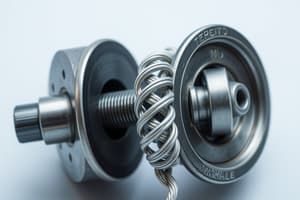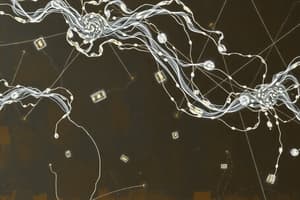Podcast
Questions and Answers
Which of the following best describes tension in physics?
Which of the following best describes tension in physics?
- A pushing force transmitted axially
- A force that causes objects to expand
- A pulling force transmitted axially (correct)
- A force that causes objects to compress
What is tension at the atomic level?
What is tension at the atomic level?
- A force that causes atoms or molecules to rotate
- A force that separates atoms or molecules (correct)
- A force that pushes atoms or molecules together
- A force that keeps atoms or molecules stationary
How is tension measured in the International System of Units?
How is tension measured in the International System of Units?
- Newtons (correct)
- Kilograms
- Meters
- Pounds
What is the opposite of tension?
What is the opposite of tension?
What do the ends of a string or other object transmitting tension do?
What do the ends of a string or other object transmitting tension do?
Flashcards are hidden until you start studying
Study Notes
Tension in Physics
- Tension is a force that is transmitted through a rope, string, or wire when it is stretched or pulled tight.
- At the atomic level, tension arises from the electromagnetic interactions between atoms or molecules, causing them to attract or repel each other.
Measuring Tension
- Tension is measured in the International System of Units (SI) in units of newtons (N) or sometimes in pounds (lb) or kilogram-force (kgf).
Opposite of Tension
- The opposite of tension is compression, where a force is applied to an object to compress or shorten it.
Transmission of Tension
- When an object transmits tension, its ends are pulled apart, exerting an equal and opposite force on the objects attached to each end.
Studying That Suits You
Use AI to generate personalized quizzes and flashcards to suit your learning preferences.




